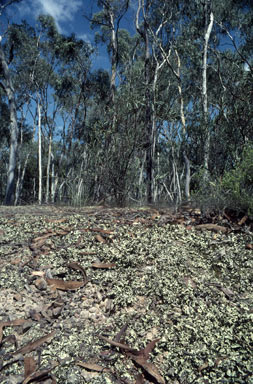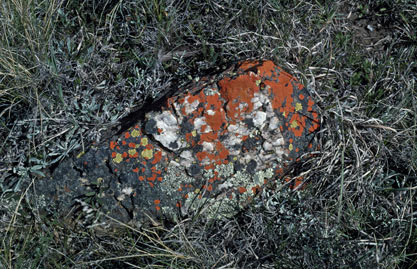 Ecology
Ecology
Habitats
You can find lichens from sea level to alpine peaks and from the hot deserts of the world to the cold arctic and antarctic. Catillaria floccosa , shown in the illustration to the right, is an Antarctic species. That's not to say that lichens are found everywhere in the world. Yes, they are found in the arctic and antarctic, but not on ice. Yes, various species can grow on sand and in deserts but not on highly mobile sand dunes. Lichens are the dominant form of life on about 8% of the world's land surface. for example, in the boreal forests of North America and Eurasia large areas of soil are covered with the so-called 'reindeer lichens', particularly species of the genus Cladina. These fruticose lichens can form dense carpets, 20 to 30 centimetres deep, at times constituting 100% of the forest understorey. In many parts of the world you will find large expanses of so-called 'bare' rock. In fact, look carefully and you'll often find little or no bare rock at all, but lichen colonies instead. In some cases ![]() the lichens are colourful, cover a large area and therefore are easily noticed but in other cases
the lichens are colourful, cover a large area and therefore are easily noticed but in other cases ![]() they are cryptic and only noticeable if you get close and look with a hand lens. These are just two examples of areas where lichens can dominate the landscape and, as you'll see later, there are other habitats where lichens, though not necessarily dominant, are significant. This page and its subsidiary pages won't give an exhaustive account of the numerous habitats in which lichens are found but you will find a discussion of some habitats in order to illustrate various challenges to and adaptations by the lichens to various conditions.
they are cryptic and only noticeable if you get close and look with a hand lens. These are just two examples of areas where lichens can dominate the landscape and, as you'll see later, there are other habitats where lichens, though not necessarily dominant, are significant. This page and its subsidiary pages won't give an exhaustive account of the numerous habitats in which lichens are found but you will find a discussion of some habitats in order to illustrate various challenges to and adaptations by the lichens to various conditions.
Mangroves are challenging environments for epiphytes since any epiphytes may be subjected to salt spray or periodic changes between moist and dry conditions. Nevertheless mangroves are home to many lichen species, most of which are found also well away in other habitats. The mangrove lichens page of the Australian Mangrove and Salmarsh Resource website gives more details about the lichens found in Australian mangroves![]() .
.
As you read through these pages you will also encounter numerous substrates, that is, what lichens grow on. Some species are restricted to very specific habitats or substrates, but others are found in more than one habitat or on several substrates. Various factors influence the distribution of lichens and a few such factors are: climate (including aspects such as yearly temperature and rainfall patterns); pollution levels; physical factors such as surface texture or degree of shading of a substrate; substrate chemistry (e.g. whether it's alkaline or acidic). For example, some lichens will only ever be found on alkaline substrates. A rock-inhabiting species that requires alkalinity could be found on an alkaline rock such as limestone, but never on an acidic rock (such as basalt, for example), You could also find such a species on soil, but only on alkaline soil. You might find the same species in an urban area on surfaces such as concrete walls or concrete roof tiles, since concrete is also alkaline. On a wall made of clay bricks you may find lime-loving lichens on the mortar between the bricks, but not on the bricks themselves. Of course, if you're a lime-loving lichen, then old bones ![]() also make a suitable substrate.
also make a suitable substrate.
Broad types of habitats, such as rainforests, grasslands and deserts are significant but it is also very important to look at the small scale when it comes to lichens. You've already seen this in the brick versus mortar example of the previous paragraph. Within a single broad habitat (such as 'woodland' for example) there are invariably numerous micro-habitats. Here's a log, a tree, a boulder, a depression – all in this one woodland area and each creating distinct surfaces, levels of exposure, chemistry, patterns of water flow and so on. In other words, different MICROHABITATS which appeal to different lichen species.
The photo on the right shows a dry sclerophyll macrohabitat on Black Mountain, Canberra. Xanthoparmelia thalli are conspicuous on the exposed, gravelly clay microhabitat in the foreground. Yet, move just a few metres away and you'd find yourself in area of tussock grass and silty soil on which Lichenomphalia chromacea ![]() is growing.
is growing.
Many habitats present considerable challenges to day-to-day survival and lichens have developed various strategies to overcome them. An obvious challenge in arid areas is water, which is typically scarce and unpredictable – but there are many lichens in arid areas, with various survival strategies. One way to overcome the challenge is to grow in protected areas, in rock crevices or at the bases of boulders or shrubs thereby getting some protection from drying winds. For more on this subject there's a separate page about LICHENS IN ARID AREAS.
Incidentally, you can find some of the arid area survival strategies in places you might not initially consider arid. Think of a street tree in any temperate zone city - far from the alps, poles and deserts of the world. The trunk of such a tree is also an arid environment, for it is exposed to the sun and the drying winds. If there are lichens on that tree. Of course a tree provides a variety of micro-habitats. If it's smooth-barked there is a difference between exposure to sun between the north and south sides of the trunk. A rough-barked trunk provides fissures, sometimes quite pronounced, and these fissures provide differing levels of shade and also channel rainfall runoff along particular pathways down the trunk. This also raises the subject of URBAN LICHENS and, as that link shows, urban areas provide both opportunities and challenges.
Though lichens can be found growing in a very wide variety of habitats some types of lichens may be precluded from certain habitats. Take a lichen such as one of the large, pendulous Usnea species, a number of which are shown here ![]() growing from near the tree-tops in a rainforest canopy. A good example is Usnea himantodes, shown here
growing from near the tree-tops in a rainforest canopy. A good example is Usnea himantodes, shown here ![]() as a herbarium specimen. This species grows on trees in open forests and rainforests in Queensland and New South Wales and, outside Australia, in the Asian and African tropics. The thallus may grow to over a metre in length but is a fairly open, branched structure and hangs, somewhat curtain-like, from its tree substrate. Such a curtain has a large surface area-to-volume ratio and so is very effective at trapping atmospheric moisture. The necessary humidity need not come from rainfall since lichen curtains are also very effective at trapping moisture carried by fogs or mists. Spiders' webs give a more commonly-seen example of the effectiveness of the water-trapping potential of such curtains. Who hasn't seen spiders' webs on foggy mornings, the strands loaded with numerous tiny beads of water? However, those lichen curtains also lose water fairly rapidly and this physical growth form would be a handicap in predominantly dry areas. Not surprisingly such curtain-like species are found in areas with high rainfall or with frequent fogs or mists. This does not mean that species with high surface area to volume ratios are confined to well-forested areas. You can find a number of such lichens (not necessarily Usnea) in what at first appear to be harsh coastal deserts. However some coastal deserts experience frequent sea mists and so there can be a narrow coastal band in which open, fruticose lichens can flourish.
as a herbarium specimen. This species grows on trees in open forests and rainforests in Queensland and New South Wales and, outside Australia, in the Asian and African tropics. The thallus may grow to over a metre in length but is a fairly open, branched structure and hangs, somewhat curtain-like, from its tree substrate. Such a curtain has a large surface area-to-volume ratio and so is very effective at trapping atmospheric moisture. The necessary humidity need not come from rainfall since lichen curtains are also very effective at trapping moisture carried by fogs or mists. Spiders' webs give a more commonly-seen example of the effectiveness of the water-trapping potential of such curtains. Who hasn't seen spiders' webs on foggy mornings, the strands loaded with numerous tiny beads of water? However, those lichen curtains also lose water fairly rapidly and this physical growth form would be a handicap in predominantly dry areas. Not surprisingly such curtain-like species are found in areas with high rainfall or with frequent fogs or mists. This does not mean that species with high surface area to volume ratios are confined to well-forested areas. You can find a number of such lichens (not necessarily Usnea) in what at first appear to be harsh coastal deserts. However some coastal deserts experience frequent sea mists and so there can be a narrow coastal band in which open, fruticose lichens can flourish.
Scarcity of water is one type of challenge but excess water can be equally challenging, leading to reduced gas exchange for the photobiont and hence a lower photosynthesis rate. Prolonged waterlogging can also lead to a breakdown in the fungus-photobiont symbiosis and the escape of the photobiont partner from the lichen. In some cases the growth habit or position of a lichen can help reduce the risk of waterlogging. For example, surface water can run off quickly from the pendulous thalli often found in rainforests and a lichen growing on a vertical surface would have less risk of immersion than one growing on a horizontal surface. In addition hydrophobic compounds may coat hyphae, making them water repellent and so allow gas exchange in the medulla even in wet periods. Despite these mechanisms there is still great variation in the ability of lichens to cope with submersion in water, some able to cope with frequent immersion (and there are even a few species of aquatic lichens) while others cannot tolerate more than a brief immersion and there are species that would suffer even from prolonged exposure to a high humidity atmosphere.
Heat, cold, dryness and waterlogging are examples of processes that can inflict severe stresses on lichens. On this page you've seen that some stresses can be reduced by non-physiological means, for example by growing in sheltered environments or by having growth forms that promote water runoff. Lichens also have physiological means of reducing the effects of stress. Given the wide variety of habitats occupied by lichens it's obvious that these stress-reduction methods are very effective and have prompted the following observation (though, in the strict botanical sense, lichens are not plants):
...it is their extraordinary high stress tolerance that enables lichens to live in places that no other plants can; the only competition lichens face in many of their habitats is from other lichens
!
![An Australian Government Initiative [logo]](/images/austgovt_brown_90px.gif)



